The Best Digital Signage Software for Interactive Digital Signage
Digital signage has come a long way, and with the industry players’ clear commitment to investing in innovation, there is no slowing down. In fact, the adoption of digital signage is on a steady rise, with 60% of enterprises without digital signage in their store planning to invest in the technology within the next two years. As more use cases and applications come up, digital signage solution providers continue to look into ways that will grab the attention of the target audience.
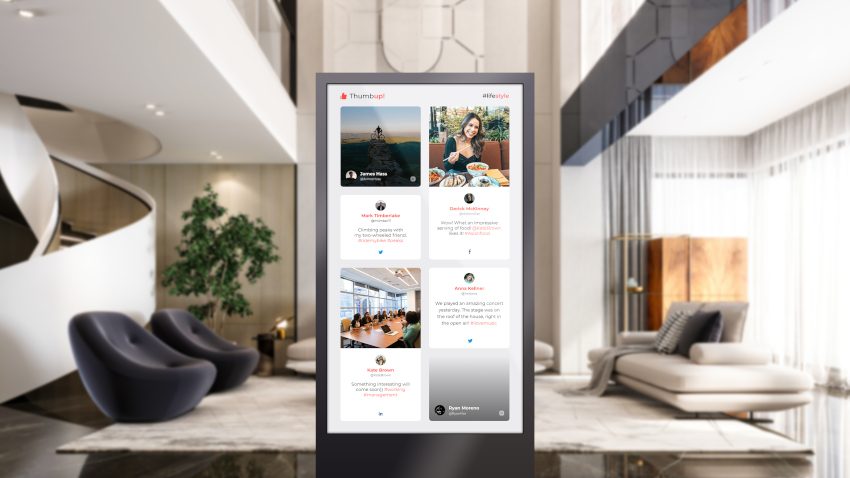
Indeed, interactivity makes a huge difference in enhancing the attention-grabbing capabilities of a digital signage system. In fact, 81% of marketers agree that interactive content grabs more attention than passive content. Adding interactivity and custom animation to your digital signage content presents an excellent opportunity to create engaging stories and effectively differentiate your brand. Of course, standing out is a big plus for every business, especially for small businesses looking to beat the competition.
Understanding Interactive Digital Signage
Interactive digital signage allows the target audience to interact with the solution and find what resources are relevant to them. Digital signage communication is often one-way with a business communicating with its audience. With interactive kiosks, communication is two-way. with businesses engaging with its audience and audiences engaging back through the digital signage. The interactivity element ensures there is active participation, effectively turning the target audience from viewers to active users. Retention is indeed better with interactive digital signage than with its passive counterparts.
As with traditional digital signage displays, the components that come together to build an interactive digital signage platform are as follows.
- Hardware: This includes the signage screens, media player, cabling, and other physical components.
- Content: This is what you want to be displayed on your screens. To encourage interactivity, you need to ensure your content is highly targeted and keep uploading new content frequently. It can be in various formats, including images, illustrations, and videos.
- Software: This content management system (CMS) provides the tools for running and managing your content.
As there are many important parts that play to the success of interactive digital signage, the content management system is a very important aspect. Incorporating an interactive and intuitive content management system ensures that you are engaging your customer to get your message across. If the content management system isn’t strong, you will not maximize your investment. If you are strategizing on what digital signage CMS is right for your project, here are the top 5 best CMS software you should immediately book a demo for.
The Best Digital Signage Software for Interactive Signage
There are several digital signage software companies providing robust solutions to meet your specific needs. For creating and managing content for highly interactive digital signage networks, here are some excellent picks.
1. Mvix
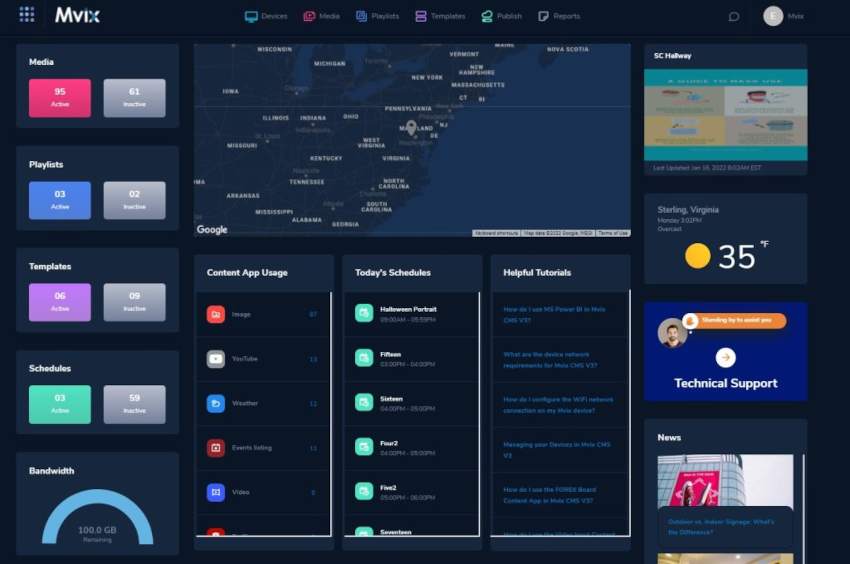
Digital signage industry leader Mvix offers powerful, cloud-based digital signage software for efficient content management from any web browser. It’s a user-friendly software solution with an intuitive user interface that makes navigation quite hassle-free, even for a first-time user. Core features such as remote management, smart playlists, playback management, content scheduling, and more, make managing multiple screens on your digital signage network easy.
Additionally, the software works well with different operating systems such as Chrome OS, Linux, Android, and web OS. Moreover, it works great with Raspberry PI and Brightsign digital signage player. Mvix works on desktops and supports mobile devices just as well.
The 1000+ templates available make designing and creating content with Mvix relatively easy. It also supports 40+ languages. It supports multiple data integrations, and you can get data for your displays from social media and other apps. Additionally, the software has added features, including user permissions and 2-factor authorization, to ensure the security of your system. Mvix also offers pricing options, and you can choose between a one-time payment for a perpetual license or a monthly fee for subscribers.
Mvix software can deliver interactive digital solutions for use across different markets, such as retail, banking, and healthcare. For example, digital signage for schools helps optimize functionality and resource allocation in the institutions of learning. Wayfinding signs, alongside digital building directories with the layouts of the school, help students, staff, and visitors find their way around campus.
Similarly, digital signs allow for the display of essential student communications and emergency notifications. Staff can interact with the signs and see what rooms and lecture halls are available for better class and event management.
2. BroadSign
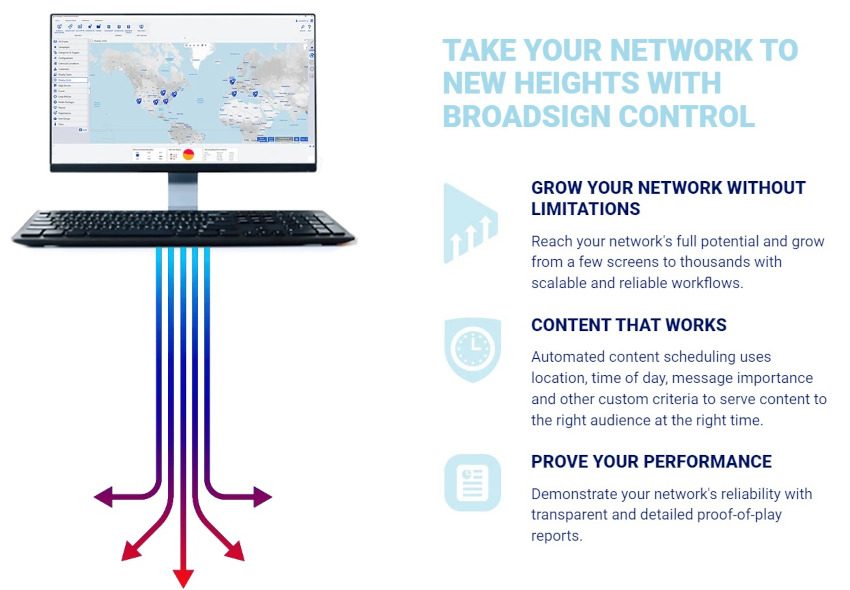
BroadSign is a cloud-based digital signage software for managing content across multiple screens. The software caters to the needs of businesses of all sizes across different industries for their ad campaigns and display of any other information.
What’s more, users create and manage content through a drag-and-drop interface. BroadSign supports multiple formats, such as images, videos, and maps. Among the key features of this software offering is content scheduling, where the users can schedule content to automatically display on the screen based on custom criteria such as time or the location of the screen.
3. Visix
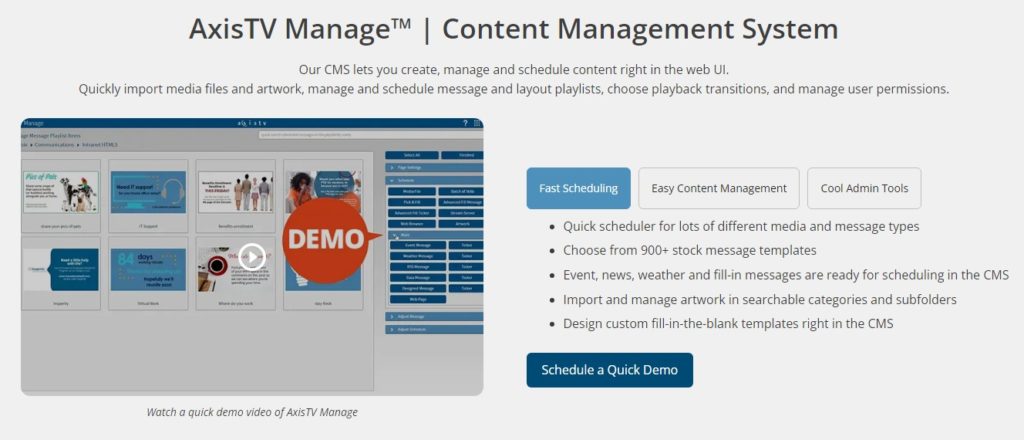
Visix is a robust, cloud-based digital signage software. It has a user-friendly interface for easy design and management of dynamic content. Using drag-and-drop widgets, users can easily create interactive content for internal communication, marketing campaigns, and brand awareness.
Furthermore, it allows for data integration with multiple data sources such as RSS feeds and web pages to drive touchscreens, video walls, and other displays, providing real-time updates. In addition to the touchscreens, there is also a voice interface for the various displays, an element that only increases the interactivity of the signs.
4. ComQi
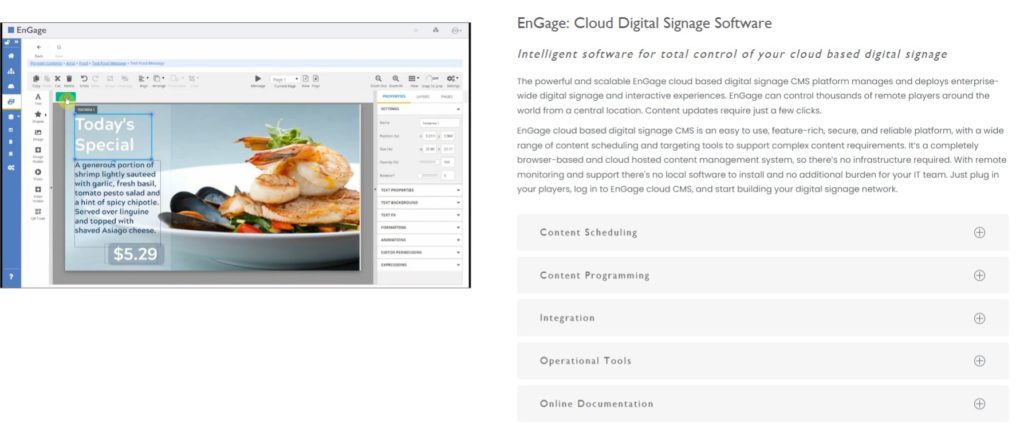
ComQi is a cloud-based digital signage software for easy content creation, scheduling, and management across multiple screens. The ComQi Engage REST API enables seamless integration with various data sources, devices, and third-party apps. As a result, it brings together more engaging content that encourages interaction with the target audience.
Alongside content management, ComQi also provides tools for device management. Users can access proof of play insights and information on the system and firmware without requiring third-party software. You can also easily recalibrate your touchscreen, reboot the network and do much more right from within the CMS.
Adoption to the Target Audience
Interactive content gets 2x more engagement than static content. With this in mind, any enterprise, big or small, must carefully consider the content that goes into its interactive digital signage. If the content is outdated and not relevant to the target audience, then no amount of touchscreens, no matter how big, will make them want to interact with the signage.
As such, it is essential to know your target audience and ensure that you adapt the content on your screens to their needs and preferences.
Choosing the Digital Signage Software
Creating and deploying interactive digital signs requires deliberate effort and investing in the right resources. Choose a free basic digital signage software, and you may find that the user interface is not easy to use or customizable. Again, the support and service may not be dependable.
For these reasons, among others, it is always best to choose and work with a dedicated CMS provider and partner. These digital signage software providers will walk you through every step of creating interactive signs, from design and content creation to the final deployment. You will also get insights into the interactivity statistics for your signage. This should help you understand how well your system performs and the return on investment.



